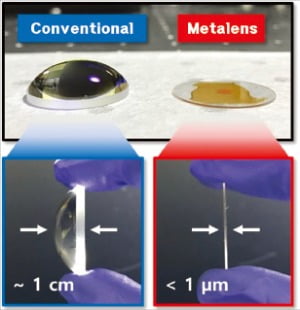A source technology that can drastically reduce the size and weight of cameras used in smartphones and autonomous vehicle lidars (laser-based sensors) has emerged.

Comparison between the thickness of the existing refractive lens (left) and the thickness of the ultra-thin metal lens developed by the research team (right).
The Ministry of Science, ICT and ICT announced on the 1st that a joint research team, including Professor Roh Jun-seok of POSTECH Mechanical Engineering Department, Han Seung-Hoon, Master of Imaging Devices Lab at Samsung Electronics Advanced Institute of Technology, and Professor Lee Heon of Korea University’s Department of Materials Science and Engineering, have succeeded in developing a’flat ultra-thin lens’. It is a new technology that can reduce the thickness of lenses used in infrared cameras by ten thousandths by using metamaterials, which are artificial materials, and nanoprinting techniques. Metamaterial refers to new materials made to reflect or refract light or sound waves by artificially changing the arrangement and structure of natural materials. Since it changes light or wavelength in a completely different direction from the natural laws of physics, it can be applied to things that are likely to appear in science fiction movies, such as invisible cloaks that create’invisible humans’, stealth devices that cannot be caught by radar, and high-resolution holograms, thereby competing for research worldwide. It is a fierce field.
Prof. Roh said, “As autonomous driving technologies such as drones and unmanned vehicles advance, the demand for ultra-thin lenses for LiDAR is increasing, but there is a fundamental limit to reducing the size and weight.” “This new technology will grow to 5 billion dollars by 2025. It will be a stepping stone to preoccupy this expected meta-lens market.”
‘1 in 10,000’ of the thickness of a normal lens… Solve the katuktu, catch the performance
Metamaterial called’innovative new material’… Fabrication of refractive lenses through nanoprinting
The World Economic Forum (WEF) selected’Small Lens Technology for Small Devices’ as one of the ’10 promising technologies that will have a big impact on the global economy’ in 2019. This is because the use of smartphones, autonomous vehicles, and drones is widespread, and demand is also expected to explode. POSTECH, Samsung Advanced Institute of Technology, and Korea University jointly developed the’original technology for ultra-thin meta-lens’, which is evaluated as having great significance in that it laid a foothold for commercialization of micro-lens one step earlier than competitors.
This technology is a technology for manufacturing small lenses (meta lenses) for small devices using meta materials. Metamaterials collectively refer to artificial materials created by combining nonmetals and polymers. It is a new material that cannot be explained by natural laws of physics. Usually, it is made by modifying the internal structure of silicon, gallium nitride (GaN), titanium oxide, etc., but the characteristics of refracting and reflecting light or sound waves are completely different. In addition to smartphones, there is active research on technologies applied to autonomous vehicles, military and medical cameras, AR (augmented reality) and VR (virtual reality) glasses.
Refractive lenses are key components of electronic and optical devices such as smartphones and digital single-lens reflex (DSLR) cameras. The lenses used in these products use a composite lens (aka optical system) composed of 8 to 9 refractive lenses in order to reduce image distortion. It is produced by mixing concave lenses, convex lenses, and zoom (for magnification and reduction) lenses.
However, as the number of lenses increases, the volume and weight increase. Reducing the volume, on the contrary, decreases the camera performance. This is why some smartphone brands have opted for an unfavorable design with the camera part protruding. The weight of a lens used in a DSLR camera is close to 4kg in the high-performance group. This is the reason for the increasing demand for thin and light lenses to prevent so-called “ka-tuk-tu” (camera pops out).
The research team has been working on metamaterials to develop high-performance and compact lenses. Previously,’electron beam lithography’ was mainly used when manufacturing metamaterials. Electron beam lithography is a method of creating a new material by engraving nano patterns on a material on a substrate by shooting an electron beam with a strong voltage. It can theoretically engrave finer patterns than ultraviolet lithography, which is a process used when manufacturing semiconductors, and has higher process freedom. However, it has the disadvantage of increasing cost due to its slow speed. After several years of repeated experiments, the research team developed a new metamaterial by dispersing silicon nanoparticles with a size of 50 nm (nanometer) in a thermosetting resin. As a result of measuring the optical properties of this new material, it showed a high refractive index (2.2) in the infrared region (940 nm). It means that a material suitable for the production of’high refractive metamaterials’ was made. It has also secured a new method for producing metamaterials by printing once without separate etching and deposition.
The research team applied the new material to the nanoprinting process to fabricate a meta lens with a diameter of 4 mm and a thickness of 1 μm (micrometer) or less. It is more than a ten thousandth thinner than a refractive lens with a thickness of about 1 cm in an infrared camera. “When we made a camera by combining this metalens and an infrared image sensor and photographed human hands, the distribution of blood vessels in the skin was clearly visible,” the researchers explained.
Joon-Seok Noh, who led this research, is considered a global metamaterial expert. Since graduating from the Department of Mechanical and Aerospace Engineering at Seoul National University and in the Ph. He has been working at POSTECH since 2014 after working at Lawrence Berkeley Research Center and Argon Research Center in the United States.
Reporter Lee Hae-seong [email protected]
